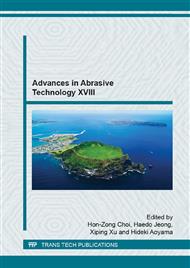p.472
p.478
p.484
p.490
p.497
p.503
p.509
p.515
p.520
Surface and Subsurface Integrity of Glass-Ceramics Induced by Ultra-Precision Grinding
Abstract:
Ultra-precision grinding is widely used in machining of the hard and brittle materials due to its high surface accuracy and machining efficiency. However, grinding inevitably brings about surface and subsurface damage that needs to be removed by the polishing processes. This study investigated the surface and subsurface integrity of glass-ceramics induced by ultra-precision grinding. The characteristics of surface roughness, surface topography and subsurface damage depth of ground glass-ceramics with diamond grinding wheels with different grain sizes were presented and compared. Discussion was also provided to explore corresponding reasons of surface and subsurface integrity induced by diamond grinding wheels with different grain sizes.
Info:
Periodical:
Pages:
497-502
Citation:
Online since:
January 2016
Authors:
Price:
Сopyright:
© 2016 Trans Tech Publications Ltd. All Rights Reserved
Share:
Citation:


